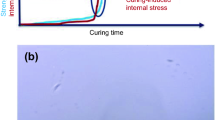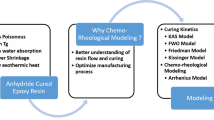Abstract
Rheology and kinetics are a pair of indispensable attributes in defining thermally reactive polymer coatings and paints. In this work, cure paths of volatile organic compound-free epoxy powder coatings, under heat, were characterized by viscoelastic and kinetic techniques. The essential rheological meanings of the gel point, the minimum complex viscosity, and the shear moduli from dynamic mechanical analysis curves were elucidated from applied formulation perspectives. Meanwhile, the maximum cure reaction rate and the peak temperature from differential scanning calorimetry exothermic profiles were quantitatively interpreted using primarily the extent of cure along with viscoelastic data. Vitrification and devitrification during cure were observed for high glass transition (Tg) epoxy formulations, unless a fast rate of heating was employed to a high enough temperature. Thorough and complete cure description provides strong insights for product development, allowing flow and cure properties to be balanced for optimal line performance. The consolidated approach is applicable to nearly all B-staged thermosetting systems of 100% solids including conditioned prepregs and a variety of adhesives per applications, as well as direct-to-metal primers or topcoats per functions.





Similar content being viewed by others
Abbreviations
- A :
-
Pre-exponential factor in cure kinetics
- E a :
-
Activation energy (J/mol)
- m, n :
-
Reaction orders in autocatalytic model
- α :
-
Extent (or degree) of cure (%)
- \(\dot{\alpha }\) :
-
Cure reaction rate, = dα/dt
- α gel :
-
Extent of cure at gelation
- \(\dot{\alpha }_{ \hbox{max} }\) :
-
Maximum cure reaction rate, = dαmax/dt
- β :
-
Rate of heating for cure, or heat rate (°C/min)
- δ :
-
Phase angle
- ΔH :
-
Enthalpy, heat of reactions, reactivity (J/g)
- γ :
-
Strain (%)
- \(\dot{\gamma }\) :
-
Strain rate (1/s)
- K :
-
Coefficient in Power law
- λ :
-
Relaxation time (s)
- De :
-
Deborah number
- E: E′, E″:
-
Tensile modulus: storage, loss (or elastic, viscous component)
- η :
-
Shear viscosity (Pa s)
- η e :
-
Extensional viscosity
- η*:
-
Complex or dynamic viscosity
- η*min, η*max :
-
Minimum viscosity, maximum viscosity
- G: G′, G″:
-
Shear modulus: storage, loss (or elastic, viscous component)
- G′min, G″min :
-
Minimum storage, loss modulus (Pa)
- G′max, G″max :
-
Maximum storage, loss modulus
- R :
-
Gas constant (8.314 J/mol K)
- T :
-
Temperature (°C or K)
- t :
-
Time (s)
- T cure :
-
Cure temperature
- T gel :
-
Temperature at gelation
- Tan(δ):
-
= G″/G′
- T g :
-
Glass transition temperature (°C)
- T peak :
-
Peak temperature on DSC exothermic curves
- τ :
-
Shear stress (Pa)
- Type 4, 5, 7 epoxy:
-
Repeating units of 5, 8, and 11, respectively, in BPA-derived resins
- υ :
-
The Poisson ratio
References
Acocella, MR, Corcione, CE, Giuri, A, Maggio, M, Maffezzoli, A, Guerra, G, “Graphene Oxide as a Catalyst for Ring Opening Reactions in Amine Crosslinking of Epoxy Resins.” R. Soc. Chem. RSC Adv., 6 (28) 23858–23865 (2016)
Wang, R, Schuman, T, “Chapter 9 Towards Green: A Review of Recent Developments in Bio-renewable Epoxy Resins from Vegetable Oils.” In: Liu, Z, Kraus, G (eds.) RSC (Royal Society of Chemistry) Green Chemistry No. 29, Green Materials from Plant Oils, pp. 202–241. The Royal Society of Chemistry, Cambridge (2015)
Chartoff, RP, Menczel, JD, Dillman, SH, “Dynamic Mechanical Analysis (DMA).” In: Menczel, JD, Prime, RB (eds.) Thermal Analysis of Polymers: Fundamentals and Applications, pp. 387–495. Wiley, Hoboken (2009)
Macosko, CW, Secor, RB, Larson, RG, “I. Principles: Constitutive Relations: Elastic Solid.” In: Macosko, CW (ed.) Rheology: Principles, Measurements and Applications, pp. 5–172. VCH/Wiley, New York (1994)
Larson, RG, “Part I: Fundamentals. Chapter 1: Introduction to Complex Fluids.” In: Larson, RG (ed.) The Structure and Rheology of Complex Fluids, pp. 3–60. Oxford University Press, New York (1999)
Eley, RR, “Applied Rheology in the Protective and Decorative Coatings Industry.” In: Rheology Reviews 2005, pp. 173–240. The British Society of Rheology, London (2005). http://www.bsr.org.uk
Eley, RR, “Applied Rheology and Architectural Coating Performance.” J. Coat. Technol. Res., 16 (2) 263–305 (2019)
Rao, MA, “Chapter 2: Flow and Functional Models for Rheological Properties of Fluid Foods.” In: Rao, MA (ed.) Rheology of Fluids, Semi-Solid, and Solid Foods: Principles and Applications, Food Engineering Series, pp. 27–58. Springer, New York (2014)
Winter, HH, “Gel Point.” In: Encyclopedia of Polymer Science and Technology, 4th Edition, pp. 1–15. Wiley, New York (2016)
Lusignan, CP, Mourey, TH, Wilson, JC, Colby, RH, “Viscoelasticity of Randomly Branched Polymers in the Vulcanization Class.” Phys. Rev. E, 60 (5, Part B) 5657–5669 (1999)
Winter, HH, Mours, M, “Rheology of Polymers Near Liquid–Solid Transitions.” Adv. Polym. Sci., 134 165–234 (1997)
Tung, CY, Dynes, PJ, “Relationship Between Viscoelastic Properties and Gelation in Thermo-setting Systems.” J. Appl. Polym. Sci., 27 (2) 569–574 (1982)
Chambon, F, Winter, HH, “Stopping of Crosslinking Reactions in a PDMS Polymer at the Gel Point.” Polym. Bull., 13 499–503 (1985)
Enns, JB, Gillham, JK, “Effect of the Extent of Cure on the Modulus, Glass Transition, Water Absorption, and Density of an Amine-Cure Epoxy.” J. Appl. Polym. Sci., 28 (9) 2831–2846 (1983)
Smith, ME, Ishida, H, “Critical Gel Phenomena in the Rheology of Epoxide Network Formation.” J. Appl. Polym. Sci., 73 (4) 593–600 (1999)
Zhang, ZQ, Wong, CP, “Flip-Chip Underfill: Materials, Process and Reliability.” In: Lu, D, Wong, CP (eds.) Materials for Advanced Packaging, pp. 307–337. Springer, New York (2009)
Takeda, S, Takashi, M, “Die Attach Adhesives and Films.” In: Lu, D, Wong, CP (eds.) Materials for Advanced Packaging, pp. 307–337. Springer, New York (2009)
Lee, WQ, “Cure Kinetics of Epoxy Powder Coatings via Differential Scanning Calorimetry: Implications on Processing and Formulation.” In: 45th International Waterborne Symposium 2018, sponsored by The University of South Mississippi, New Orleans (2018)
Wicks Jr., ZW, Jones, FN, Pappas, SP, Wicks, DA, “Chapter 2: Polymerization and Film Formation.” In: Wicks Jr., ZW, Jones, FN, Pappas, SP, Wicks, DA (eds.) Organic Coatings: Science and Technology, 3rd Edition, pp. 7–40. John Wiley & Sons, Hoboken (2007)
Prime, RB, “Thermosets.” In: Turi, EA (ed.) Thermal Characterization of Polymeric Materials, 2nd Edition, pp. 435–563. Academic Press, San Diego (1997)
Kissinger, HE, “Reaction Kinetics in Differential Thermal Analysis.” Anal. Chem., 29 1702–1706 (1957)
Lee, WQ, “Fusion Bonded Epoxy Rebar Powder Coatings.” US Patent, pending, filed on 12/17/2018
Dusi, MR, Galeos, RM, Maximovich, MG, “Physiorheological Characterization of a Carbon/Epoxy Prepreg System.” J. Appl. Polym. Sci., 30 (5) 1847–1857 (1985)
Fuller, B, Gotro, JT, Martin, GC, “Chapter 12: Analysis of the Glass Transition Temperature, Conversion, and Viscosity during Epoxy Resin Curing.” In: Craver, CD, Provder, T (eds.) Polymer Characterization: Physical Property, Spectroscopic, and Chromatographic Methods, Advances in Chemistry Series, Vol. 227, pp. 215–234. American Chemical Society, Washington, DC (1990)
Acknowledgments
The author greatly thanks Robert G. Polance, a Senior Staff R&D Chemist at the Sherwin-Williams Company in Minneapolis, the USA, for his DMA operations and valuable perspectives in support of this work.
Author information
Authors and Affiliations
Corresponding author
Additional information
Publisher's Note
Springer Nature remains neutral with regard to jurisdictional claims in published maps and institutional affiliations.
Rights and permissions
About this article
Cite this article
Lee, W.Q. Thermal characterization of solvent-free epoxy coatings by rheology and kinetics combined. J Coat Technol Res 17, 145–155 (2020). https://doi.org/10.1007/s11998-019-00248-9
Published:
Issue Date:
DOI: https://doi.org/10.1007/s11998-019-00248-9




